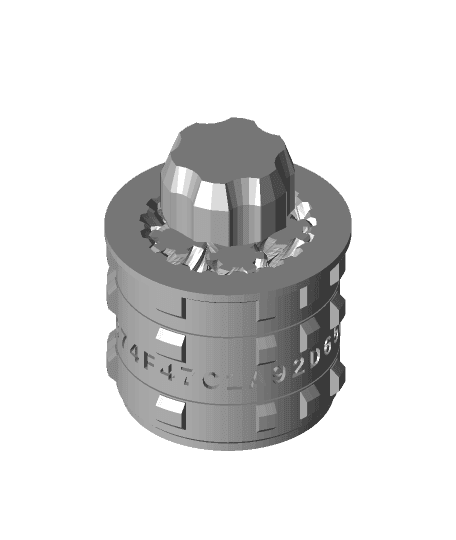Model originally uploaded to Thingiverse at https://www.thingiverse.com/thing:4571251.
Updated version with decorative pattern and smaller, updated gearbox. First attempt at encoder wheel.
The embossed pattern requires an external workflow with MeshLab to simplify the mesh, so the Customizer won't handle that. I have however incorporated a hardcoded pattern using stl2scad to generate the pattern() module. Exporting, simplifying and importing an STL file is still more convenient, I think.
Print at 0.2mm layer height and ensure there is a 1-layer gap in the ring gears after slicing. Use a sharp edge to de-laminate the 1-layer gaps (stop when you hear the "crack"). Turn the knob just a little to get the gears moving, working back and forth gently. Then apply petroleum jelly or lubricant of choice to gears.
For the encoder version, think of 3d printed holes more as "guides" for a drill bit.
SPOILERS BELOW
The first puzzle box I made of this design had only a brute force solution. Turn the knob (a lot), open the box. Not much of a puzzle. Then I added indicator holes to show where the gears need to align to open the box. In theory this should be all that is needed (without counting gear teeth) to determine gear ratios and deduce the next alignment but still quite tedious and not at all fun and requires some insight into how the internal mechanism works.
The idea of an encoder wheel to show how far away and in which direction to turn makes it a much more interesting challenge, once you deduce how to read the encoder wheel by external observation alone. You can pretty quickly determine whether you are 100 turns clockwise or many thousands of turns anti-clockwise away from a solution.
In a nutshell, the layers of gears turn at fractionally different rates. For every turn of the bottom ring, the next ring up turns by some fraction and we place a mark here, such as an arrow, coloured dot, number or letters of a secret message. In this first attempt I have chained each successive ring to the one below such that when the dot aligns on the lower ring, a value may be read off the higher.
This will tell you how many turns ring n has made relative to ring n-1, which is not actually what I was aiming for as it still requires some calculation to determine when the next alignment occurs when you are deep in the hole. I need to make some changes in the ratio calculations so that the n'th ring can only be read when all rings lower align. That way it functions more like the digits of a counter with the least significant number of turns at the bottom and the counts of all previous cycles encoded as you move higher up the chain.
As to the positioning of the indicator marks, they have been deliberately placed to require the victim turn the puzzle over and inspect it from all sides. They could just have easily been placed all in a row on one side if this mechanism were to be used for an actual counter or digital clock.
